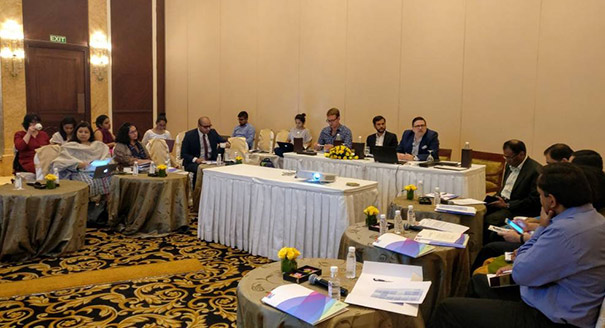Registration
You will receive an email confirming your registration.
The idea of Bay of Bengal as a multilateral, strategic, and economic community has engendered multiple interests and narratives around the bay. Therefore, identifying potential areas of cooperation would involve examining the geopolitical landscape manifested in the discourses of this region.
Carnegie India’s Bay of Bengal Initiative, in partnership with Friedrich-Ebert Stiftung India, organized a workshop to map the discourses surrounding the Bay in India, which can be used to identify opportunities for cooperation by locating the center of political activity.
DISCUSSION HIGHLIGHTS
- Economic Integration Around the Bay: Participants identified two narratives that associated the bay’s economic growth with India. One narrative proposed that India’s natural role in a multilateral framework should be to actively facilitate economic growth in the region. The second held that economic growth resulting from an integrated bay, regardless of New Delhi’s active role, would lead to India’s growth. Participants acknowledged that the second narrative was more popular in India’s littoral states in the south and in the northeastern region (NER). They explained that historical, cultural, and trade links connected these Indian states to other Southeast Asian states around the bay and could be revived via India’s eastern seaboard.
- Boosting Regional Connectivity: Participants highlighted several narratives that stress the importance of multi-modal connectivity to enhance regional cooperation, integration, and economic growth. One view, they said, contends that greater connectivity, especially through the Bay of Bengal Initiative for Multi-Sectoral Technical and Economic Cooperation (BIMSTEC), could also contribute toward peacebuilding and stabilization in conflict-ridden areas such as the NER. This perspective indicates that the basis of sharing natural resources such as rivers, should shift from bilateral frameworks to incorporate regional level cooperation, participants suggested. Other discussants put forth a parallel narrative that emphasized the role of local stakeholders in determining the success of resourcing-sharing and connectivity projects.
- India’s Look and Act East Policy: Some participants believed that India’s renewed focus on regional integration through the Bay of Bengal is a strategic narrative seeking to isolate Pakistan by creating alternatives such as BIMSTEC to the South Asian Association for Regional Cooperation (SAARC). Others pointed to the view that the Bay of Bengal as a region can facilitate middle power coalitions between India and like-minded states such as Singapore, Australia, and Japan. Finally, participants added, the narratives of “look” and “act” east are driven by economic imperatives to connect with the high-growth economies of Southeast Asia and ASEAN. Whether to contain China or to promote Asian multilateralism, they explained, these narratives emphasize the bay and its coastal areas as one of the key theatres for strategic and economic competition.
- Common Security Challenges: Another perspective participants discussed relates to the importance of regional cooperation in tackling non-traditional security challenges around the bay, including humanitarian assistance and disaster response, illegal fisheries, and trafficking. This viewpoint emphasizes the potential effect of climate change on the region, which could cause cross-border movements to accelerate and intensify conflicts. Participants discussed the idea that maritime security in the Bay of Bengal could be managed through a common security framework that could also serve to expand India’s sphere of influence. For several of these positions, they added, the Bay of Bengal region hosts a variety of cross-border and transnational challenges that can only be addressed by collective action and cooperative behavior.
- Alternative Perceptions on Integration: Participants observed that one of the dominant narratives in New Delhi, especially in government, is to further domestic development by pursuing greater international integration in the bay. However, they said, this idea sometimes clashes with alternative perspectives that privilege economic protectionism and which are, therefore, more hesitant about regional connectivity plans. Participants identified such views in the context of the NER, where certain civil society organizations and insurgent groups oppose cross-border integration and other major developmental efforts. Alternative discourses from bordering communities, smugglers, and local politicians could therefore play a spoiler role and hinder the more popular integration narratives, they concluded.
This event summary was prepared by Sharanya Rajiv, researcher at Carnegie India, with inputs from Dhishana Kidambi and Aarushi Aggarwal, interns at Carnegie India.
